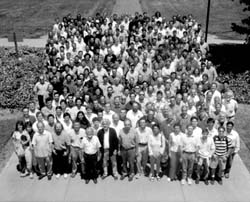 |
|
Interactions - Communicating particle physics in the 21st century
Time for communicators to catch up - If large collaborations can achieve one goal, why can't labs speak in harmony? by Neil Calder
MENLO PARK, Calif.—In high-energy
physics, we are accustomed to dealing with
paradoxes. We build huge detectors for tiny
particles. Studying the infinitesimally small
contributes to our understanding of the
farthest reaches of the universe.
But we have created for ourselves a paradox
that produces internal friction and heat, yet precious little light. Although we
are outstanding collaborators, we don’t communicate with a unified voice.
Competition between labs is a healthy thing that drives the standard of
machine performance and detector efficiency ever higher, and has never
precluded excellent collaboration between competing labs. However, a good
story can only be made better for the media by a dose of rivalry. They will
always seek it out.
From the UA1 and 2 at CERN in the 1980s; ZEUS and H1 at DESY; DZero
and CDF at Fermilab; CERN’s LEP experiments; BaBar at SLAC; Belle at
KEK, and the massive LHC experiments, HEP has set new standards in
international collaboration. All these detectors are monuments to our ability
to work constructively together. Physicists take to collaboration like ducks to
water; they are more at home in it than out of it. The Web germinated in a
hothouse of collaboration, and now computational grid technologies are riding
on the data infrastructure established among HEP institutes.
All our experiments are international, and experimental results are frequently
confirmed by other groups. Clumsy communication, spotlighting the work of
an individual laboratory rather than the wider
community, is definitely unwise. Particle physics is
defined by extensive and successful collaboration.
Particle physics communication must meet the
same high standards.
Fermilab’s Judy Jackson was the catalyst for
regular meetings of the heads of communications
from the world’s leading particle physics labs.
Berkeley, Brookhaven, CERN, DESY, Fermilab,
Gran Sasso, Jefferson Lab, KEK and SLAC are
all represented in this group, currently named
the International Committee for Science
Communication (ICSC).
Almost all our labs are involved in the LHC, and
clear communication among all partners is vital.
The future Linear Collider will be an international
initiative from the start, and an International Linear
Collider Steering Group is already being set up.
A unified communication strategy among participants
is absolutely essential. The next meeting of ICSC
will be held during the July ICHEP conference in
Amsterdam. Already on the agenda are proposals
for pooling resources and aligning our communications
activities. It’s about time!
Thus, things are moving internationally. What about
within the U.S.? In January 2002, the HEPAP longrange
planning group published its plan for the
next 20 years of particle physics. This plan outlines
an exciting program with elements (a Linear
Collider springs to mind) that will demand tight
teamwork inside the American HEP community.
The communications offices in our laboratories
must step up common projects to create a
unified voice of particle physics. DOE PULSE
(www.ornl.gov/news/pulse) has set a good example
to speak with one voice for all the DOE labs.
Meanwhile, Fermilab and SLAC communications
offices are already moving as a team. An HEP
news web space, “Interactions.org,” will launch
in June and be followed by further joint activities.
Perhaps the time is ripe for a collaborative print
publication for HEP in the U.S.? The future in
communications is not lab-based, but crossnational
and international.
|

 If our enviable skill lies in mixing powerful collaboration cocktails, why
has this skill been largely ignored by the media, while our rivalries have
been highlighted? Collaboration requires communication, and the physics
community has shown the way. Unfortunately—and herein lies the paradox—
in this respect the communications functions of the major centers have
been slow to catch up. As the field became increasingly international,
and collaboration was woven into its fabric, the labs’ communication
offices generally missed the trend and continued to trumpet the success
of individual labs. That was, and is, a mistake.
If our enviable skill lies in mixing powerful collaboration cocktails, why
has this skill been largely ignored by the media, while our rivalries have
been highlighted? Collaboration requires communication, and the physics
community has shown the way. Unfortunately—and herein lies the paradox—
in this respect the communications functions of the major centers have
been slow to catch up. As the field became increasingly international,
and collaboration was woven into its fabric, the labs’ communication
offices generally missed the trend and continued to trumpet the success
of individual labs. That was, and is, a mistake.
 The first steps have already been taken.
The first steps have already been taken.